US goods and services trade deficit jumped 8.4% to USD -55.5B in May, wider than expectation of -53.2B. It’s also the highest level this year. Exports rose 2.0% to USD 210.6B while imports rose 3.3% to USD 266.2B. Trade deficit with China widened to USD -31.1B.
US initial jobless claims dropped -8k to 221k
US initial jobless claims dropped -8k to 221k in the week ending June 29, slightly above expectation of 220k. Four-week moving average of initial claims rose 0.5k to 222.25k. Continuing claims dropped -8k to 1.686m in the week ending June 22. Four-week moving average of continuing claims dropped -1.75k to 1.687m.
ADP jobs growth at 102k, missed expectation, job market continues to throttle back
ADP report shows private sector employment grew 102k in June, below expectation of 140k. Though, it’s already a strong rebound from May’s 41k (revised from 27k).
“Job growth started to show signs of a slowdown,” said Ahu Yildirmaz, vice president and co-head of the ADP Research Institute. “While large businesses continue to do well, small businesses are struggling as they compete with the ongoing tight labor market. The goods producing sector continues to show weakness. Among services, leisure and hospitality’s weakness could be a reflection of consumer confidence.”
Mark Zandi, chief economist of Moody’s Analytics, said, “The job market continues to throttle back. Job growth has slowed sharply in recent months, as businesses have turned more cautious in their hiring. Small businesses are the most nervous, especially in the construction sector and at bricks-and-mortar retailers.”
UK PMI services dropped to 50.2, all surveys point to -0.1% GDP contraction in Q2
UK PMI Services dropped to 50.2 in June, down from 51.0 and missed expectation of 51.0. That’s a also a three-month low, just above 50 no-change mark. All Sector PMI dropped to 49.2, down from 50.7, signalling a reduction in overall private sector business activity for the first time in 35 months.
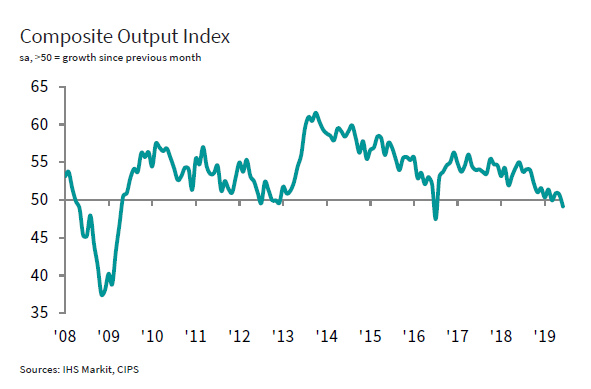 Chris Williamson, Chief Business Economist at IHS Markit, which compiles the survey:
Chris Williamson, Chief Business Economist at IHS Markit, which compiles the survey:
“The near-stagnation of the services sector in June is one of the worst performances seen over the past decade and comes on the heels of steep declines in both manufacturing and construction. Collectively, the PMI surveys indicate that the economy has slipped into contraction for the first time since July 2016, suffering the second-steepest fall in output since the global financial crisis in April 2009.
“The June reading rounds off a second quarter for which the surveys point to a 0.1% contraction of GDP.
“The latest downturn has followed a gradual deterioration in demand over the past year as Brexit-related uncertainty has increasingly exacerbated the impact of a broader global economic slowdown. Risks also remain skewed to the downside as sentiment about the year ahead is worryingly subdued, suggesting the third quarter could see businesses continue to struggle.
“One ray of hope came from a further rise in employment as firms continued to hire new staff despite the drop in output, but the resulting decline in productivity signalled was the largest in the survey’s 20-year history.
“Average selling prices for goods and services meanwhile rose at one of the slowest rates seen over the past three years, despite steeply rising costs, boding ill for corporate profits.
“The worsening picture will put further pressure on the Bank of England to add stimulus. For policymakers to not loosen policy with the all sector PMI at its current level would be unprecedented in the survey’s two-decade history.”
Eurozone PMI Composite finalized at 52.2, indicative of 0.2% growth in Q2
In June, Eurozone PMI Services is finalized at 53.6, revised up from 53.4 and up fro May’s 52.9. PMI Composite is finalized at 52.2, revised up from 52.1 and up from May’s 51.8. Among the member states, Italy PMI Composite was at 3-month high of 50.1. Spain was unchanged at 52.1. Germany was unchanged at 52.6. France hit 7-month high at 52.7.
Chris Williamson, Chief Business Economist at IHS Markit said:
“The June PMI surveys indicate that the pace of eurozone economic growth picked up at the end of the second quarter, though it would be wrong to get overly excited by the upturn. The survey is indicative of GDP merely rising by just over 0.2% in the second quarter, and a deterioration of business expectations for the year ahead to one of the lowest seen for over four years suggests the business mood remains sombre. Downside risks to the outlook prevail amid trade war worries, rising geopolitical uncertainty and slowing global economic growth.
“Looking at the largest states, the survey data are consistent with GDP growth easing sharply to 0.4% in Spain and only modest 0.2% expansions in both France and Germany. Italy is on course to see a 0.1% decline.
“Growth is being fuelled by the service sector which is helping offset the deep manufacturing downturn. However, a major concern is that, the longer the manufacturing slump persists, the greater the likelihood of the weakness spilling over to services, where the resilience in the face of the factory sector’s downturn so far this year is looking increasingly unusual.
“Inflationary pressures have also moderated as weak demand prompted companies to increasingly compete on price.
“Given the relatively weak current and future growth being signalled by the PMI and the accompanying slide in inflationary pressures, we expect to see renewed stimulus from the ECB in coming months.”
Australia trade surplus jumped to record high, building approvals recovered
Australia trade surplus widened to a fresh record high of AUD 5.7B in May, up fro AUD 4.8B in April, and beat expectation of USD 5.3B.
Exports rose AUD 1,442M (4%) to AUD41,585m. Non-rural goods rose AUD 1,316M (5%), rural goods rose AUD 46M (1%) and non-monetary gold rose AUD 22M (1%). Net exports of goods under merchanting fell AUD 1M (5%). Services credits rose AUD 58M (1%).
Import rose AUD515m (1%) to AUD 35,839M. Capital goods rose AUD 348M (5%), non-monetary gold rose AUD 68M (17%) and intermediate and other merchandise goods rose AUD 66M (1%). Consumption goods fell AUD 73M (1%). Services debits rose AUD 107M (1%).
Also from Australia, building approvals rose 0.7% (seasonally adjusted) in May, versus expectation of 0.0%. Rise in Victoria (14.4%) drove the national increase. Meanwhile falls were recorded in Queensland (6.3%), Western Australia (4.7%), South Australia (2.9%) and Tasmania (1.2%), while New South Wales was flat. Private dwellings excluding houses rose 1.2 per cent, while private house approvals decreased 0.3 per cent.
BoJ Funo: Necessary to maintain low rates for prolonged period, but no need to ease further
BoJ board member Yukitoshi Funo said it’s necessary to maintain current ultra-loose monetary policy. However, he saw no need to ramp up stimulus for now.
Funo said, “given price growth and inflation expectations aren’t heightening much, it’s necessary to maintain sufficiently low rates for a prolonged period to achieve the BoJ’s price target.” However, he’s also optimistic that “we can expect Japan’s economy to recover in the latter half of this year”. And, “as such, I see no need to ease policy further now,”
He also noted the forward guidance is already leaving open the possibility of the BoJ maintaining current policy for long. “We say ‘at least’ until spring 2020 because there’s a good chance current low rates will be maintained beyond spring next year.”
IMF Lagarde nominated to be next ECB president
After three days of marathon summit negotiations, EU leaders have finally agreed to nominate two women for the two top posts. France’s IMF Managing Director Christine Lagarde is chosen as the successor of Mario Draghi as ECB President. German Defence Minister Ursula von der Leyen, a close ally of Chancellor Angela Merkel, would succeed Jean-Claude Juncker as European Commission President.
In other decision, Belgium’s Liberal caretaker Prime Minister Charles Michel would overtake Donald Tusk as European Council President. Spain’s acting Foreign Minister, Josep Borrell, is nominated as EU’s foreign policy chief.
Fed Mester: Too soon to decide to cut interest rate
Cleveland Fed President Loretta Mester said in a speech that she will be monitoring incoming data to determine if her baseline outlook of sustainable-growth remains intact. And for now, it’s “too soon” to make that determination. Hence, she said, “I prefer to gather more information before considering a change in our monetary policy stance.”
To be more specific, Mester added, “if I see a few weak job reports, further declines in manufacturing activity, indicators pointing to weaker business investment and consumption, and declines in readings of longer-term inflation expectations, I would view this as evidence that the base case is shifting to the weak-growth scenario. In this scenario, the economy’s short- to medium-term equilibrium interest rate would be moving down, and our policy rate could need to move down ”
BoE Carney: Global negative spillovers to UK increasing, drag from Brexit uncertainties intensifying
BoE Governor Mark Carney said in a speech that the robust, broad-based expansion in the global economy has turned into a widespread slowdown. He warned “the latest actions raise the possibility that trade tensions could be far more pervasive, persistent and damaging than previously expected.” Risks have shifted to the downside.
Regarding UK, Carney said Q2 is likely to be “considerably weaker” than Q1. Also, “recent data also raise the possibility that the negative spillovers to the UK from a weaker world economy are increasing and the drag from Brexit uncertainties on underlying growth here could be intensifying.” Also, “underlying growth in the UK is currently running below its potential, and is heavily reliant on the resilience of household spending.”
Further, Carney warned “a no deal outcome would result in an immediate, material reduction in the supply capacity of the UK economy as well as a negative shock to demand. And, “as in other advanced economies, if there is a material trade shock, other policies, including fiscal policy, would likely need to play important roles in supporting the economy.”
Aussie lifted as RBA Lowe talks four developments that will help the economy
Australian Dollar is apparently lifted by some positive comments by RBA Governor Philip Lowe in a speech. He noted that the two recent rate cuts, including today’s, will “make an important contribution to putting us on a better path and winding back spare capacity”. More importantly, he pointed out four developments that will help the economy.
Firstly, borrowing costs for almost all borrowers are now the lowest they have ever been. It’s partly because of the RBA cuts and partly due to tighter credit spreads. Secondly, terms of trade have risen again, largely due to higher iron ore prices. And RBA expects a “solid upswing” in the resources sector. Thirdly, exchange rate has depreciated over the past couple of years. Fourthly, RBA expects stronger growth in household disposable income over the next couple of years, due to low and middle income tax offset.
Together with the downside risks, globally and domestically, “what all this means for us here in Australia is yet to be determined.” Lowe reiterated “we will be closely monitoring how things evolve over coming months”. And, “the Board is prepared to adjust interest rates again if needed”.
SNB Zurbruegg: Will stick to boring expansionary policy
SNB Deputy Chairman Fritz Zurbruegg said the central bank will stick to the boring expansionary monetary policy today.
He said, “we are boring and are sticking to our expansionary monetary stance.” He reiterated “we speak of negative interest rates and a readiness to intervene in the foreign exchange markets.” And he emphasized “we have flexibility and room to manoeuvre on both core instruments. We are absolutely convinced we can use these tools and will continue to do so.”
Also Zurbruegg he noticed that international developments are having strongest influences on the Franc exchange rate. However, “it is not a given that we have to react to each and every development.”
UK PMI construction dropped to 43.1, worst contraction over a decade
UK PMI Construction dropped sharply to 43.1 in June, down from 48.6 and missed expectation of 49.2. It’s also the worst contraction since April 209. Markit noted that business activity declined for second month running. There was sharpest drop in house building for three years. And, new orders shrank as political uncertainty hits client confidence.
Tim Moore, Associate Director at IHS Markit, which compiles the survey:
“The latest survey reveals weakness across the board for the UK construction sector, with house building, commercial work and civil engineering activity all falling sharply in June. Delays to new projects in response to deepening political and economic uncertainty were the main reasons cited by construction companies for the fastest drop in total construction output since April 2009. While the scale of the downturn is in no way comparable that seen during the global financial crisis, the abrupt loss of momentum in 2019 has been the worst experienced across the sector for a decade.
“Greater risk aversion has now spread to the residential building sub-sector, as concerns about the near-term demand outlook contributed to a reduction in housing activity for the first time in 17 months.
“Construction companies reported a continued brake on commercial work from clients opting to postpone spending, with decisions on new projects often pending greater clarity about the path to Brexit. Latest data meanwhile indicated another sharp fall in civil engineering, which also reflected delayed projects and longer wait times for contract awards.
“Worrying signals from the survey’s forward-looking indicators make it almost impossible to sugarcoat the Construction PMI data in June. In particular, new orders dropped to the largest extent for just over 10 years, while demand for construction products and materials fell at the sharpest pace since the start of 2010.
“A continued lack of new work to replace completed projects illustrates the degree of urgency required from policymakers to help restore confidence and support the long-term health of the construction supply chain.”
Eurozone PPI -0.1% mom, 1.6% yoy in May
Eurozone PPI came in at -0.1% mom, 1.6% yoy in May, versus expectation of 0.1% mom, 1.8% yoy. In April, PPI was at -0.3% mom, 2.6% yoy.
Comparing by main industry grouping, PPI dropped -0.6% mom in energy sector and by -0.1% mom in intermediate goods. PPI rose 0.1% mom in capital goods and durable consumer goods, and by 0.2% in non-durable consumer goods. Prices in total industry excluding energy was flat.
German retail sales dropped -0.6% mom in May, 10-year bund yield hits new record low
German retail sales dropped -0.6% mom in May, well below expectation of 0.5% mom. Compared with 2018, for the first fives months of the year, retail sales rose 2.8% in real terms. The weak data dampened hope that domestic demand could offset the drag from global trade on the export-led economy. Euro is steady after the release. But German 10-year bund yield is extending recent record run, hitting as low as -0.362 so far today.
USTR proposes tariffs on additional USD 4B of EU products
Just days after agreeing to stop tariff escalation with China, US is now turning to EU. The US Trade Representative proposed tariffs on additional EU imports, as countermeasures to harm caused by EU aircraft subsidies. A “supplemental list” of 89 subheadings with approximate trade value of USD 4B was proposed. The list includes olives, Italian cheese and Scotch whiskey, etc.
That’s additional to the USD 21B in EU imports published on April 12. A hearing will be held on the proposed additional products on August 5. But US could immediately impose increased duties on the products included in the initial list, if the WTO arbitrator issues a decision before the public comment period ends.
Trump: Trade negotiations with China essentially has already begun
Trump said that trade negotiations with China “essentially has already begun”. And, negotiators were “speaking very much on phone they are also meeting”. He remained optimistic and said “I think we have a good chance of making a deal”.
Though, he emphasized that China has had a “big advantage”over the US in trade for “many years”. Hence, “obviously you can’t make a 50-50 deal. It has to be a deal that is somewhat tilted to our advantage.”
China to abolish foreign ownership in finance industry in 2020, a year earlier
Chinese Premier Li Keqiang pledged, in the World Economic Forum in northeastern Chinese port city of Dalian, to further open up the finance and manufacturing industry. Li said, “We will achieve the goal of abolishing ownership limits in securities, futures, life insurance for foreign investors by 2020, a year earlier than the original schedule of 2021.”
Additionally, manufacturing sector, including auto industry, will be opened by further by reduction in negative investment list that restricts foreign investment in some areas. Besides, the government will also reduce restrictions, in 2020, on market access in value-added telecoms services and transport sectors.
Li also noted “global economic risks are rising somewhat, international investment and trade growth is slowing, protectionism is rising and unstable and uncertain factors are increasing”. And, “some countries have taken measures including cutting interest rates, or sent clear signals on quantitative easing.” But he pledged China won’t resort to competitive currency devaluation but keep the exchange rate stable at a reasonable and balanced level.
AUD continuing recovery as RBA maintains easing bias but doesn’t turn more dovish
Australian Dollar recovered earlier today ahead of RBA rate decision. Some knee-jerk reactions were seen after RBA announced the highly anticipated 25 bps rate cut to 1.00%. But AUD/USD quickly found its footing as the accompanying statement revealed nothing special, and doesn’t indicate a drastic dovish turn. While RBA opens the door for more rate cut ahead, upcoming developments, including new economic projections in August, would play an important part in deciding when the next cut would be delivered.
The most important part of the statement is that “the Board will continue to monitor developments in the labour market closely and adjust monetary policy if needed to support sustainable growth in the economy and the achievement of the inflation target over time”. It’s self-explanatory that RBA is open to further easing.
Globally, RBA maintained that outlook “remains reasonable”. Domestically, RBA acknowledged the below trend 1.8% growth in Q1. But it noted that “central scenario for the Australian economy remains reasonable, with growth around trend expected.” Consumption continues to be the main domestic uncertainty”.
Employment growth has “continued to be strong”. But again, ” labour market outcomes suggest that the Australian economy can sustain lower rates of unemployment and underemployment.” Inflation pressures “remain subdued”. But inflation is expected to pick up to “around 2 per cent in 2020 and a little higher after that”. On the positive side, RBA noted t some tentative signs that houses prices are “now stabilizing” in Sydney and Melbourne.




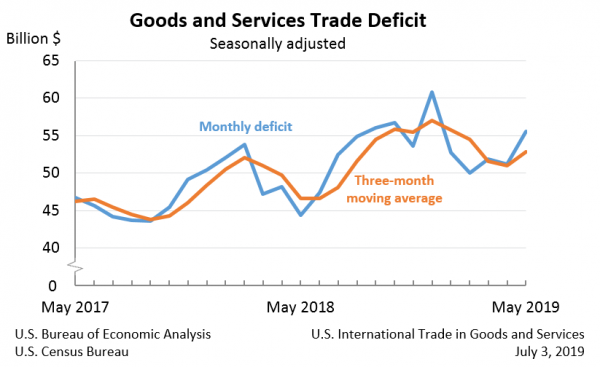
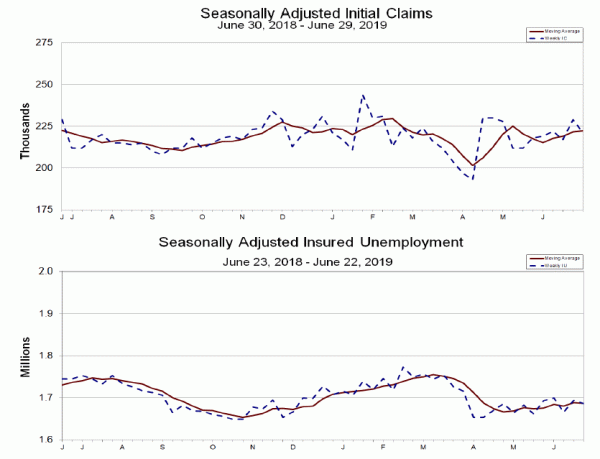

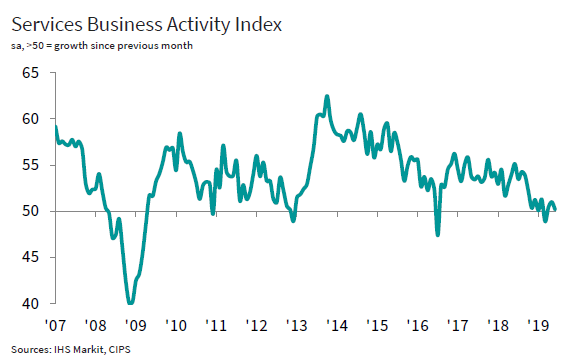
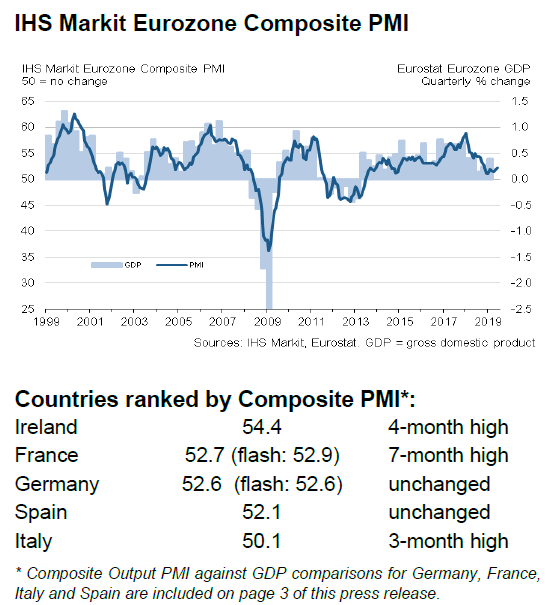
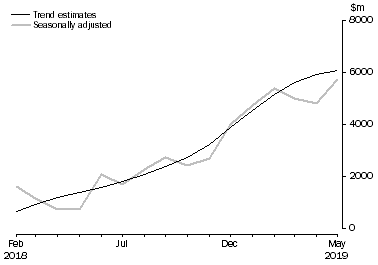
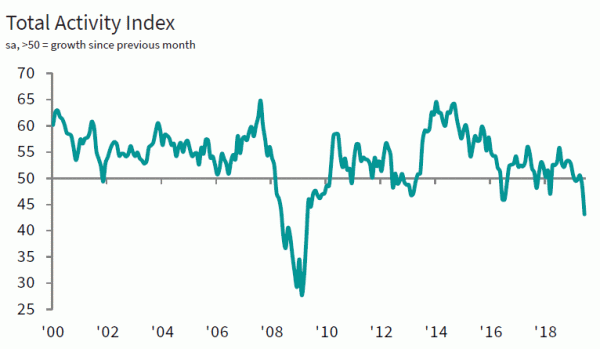
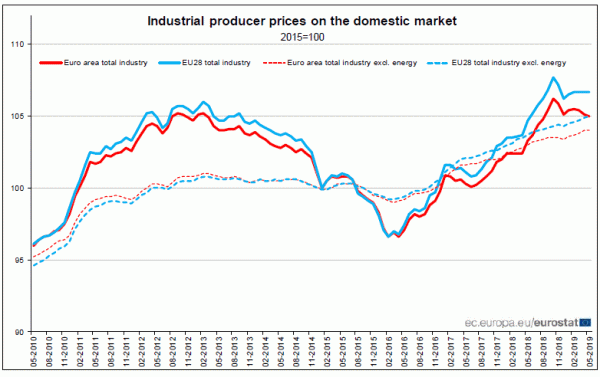
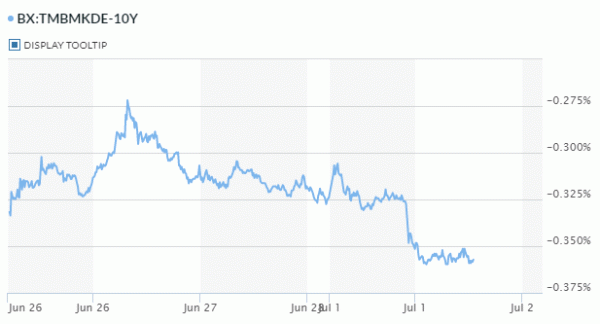


US ISM non-manufacturing dropped to 55.1, mixed sentiment on trade and tariffs uncertainty
US ISM Non-Manufacturing Composite dropped to 55.1 in June down from 56.9 and missed expectation of 56.0. Looking at some details, Business Activity dropped -3.0 to 58.2. New Orders dropped -2.8 to 55.8. Employment dropped -3.1 to 55.0.
ISM noted in the release: “Although the non-manufacturing sector’s growth rate dipped in June, the sector continues to reflect strength. The comments from the respondents reflect mixed sentiment about business conditions and the overall economy. A degree of uncertainty exists due to trade and tariffs.”
Full release here.